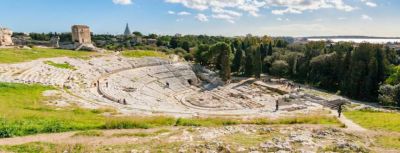Quest’articolo descrive Siracusa, una città siciliana che si trova sud-est dell’isola. Siracusa è ricca di luoghi iconici. Per esempio, il teatro greco è importantissimo per la cultura. Il teatro è uno dei più grandi al mondo ed è completamente scolpito nella pietra. C’è l’orecchio di Dionisio, una grotta fatta a mano. Al Museo Archeologico Regionale Paolo Orsi, sono in mostro gli artefatti dei templi greci e romani. C’è la Fonte Aretusa, una sorgente d’acqua dolce ed anche l’isola Ortigia. La prossima volta che ti trovi in Sicilia, fai un tour di Siracusa.
More than any other city in Sicily, Siracusa encapsulates the island’s timeless beauty best. Ancient Greek ruins rise towards the setting sun, baroque piazzas are the setting for cafes and shops, medieval streets lead down to the sparkling aqua sea.
This 2,700-year-old city played a key role in ancient times, when it was one of the major powers of the Mediterranean world. Siracusa (Syracuse) is located in the southeast corner of the island of Sicily, next to the Gulf of Syracuse beside the Ionian Sea. The city was founded by Ancient Greek Corinthians and Teneans and became a very powerful city-state. Syracuse was allied with Sparta and Corinth and exerted influence over the entirety of Magna Graecia, of which it was the most important city. In the modern day, the city is listed by UNESCO as a World Heritage Site along with the Necropolis of Pantalica.
In Siracusa, the ancient sites are endless. The Greek Theatre, one of the largest in the world, is entirely carved out of rock. In ancient times it was used for plays and popular assemblies. Today it is the place where the Greek tragedies live again through the Series of Classical Performances that take place every year.
The legendary Ear of Dionysius is the most famous cave in Siracusa. Its moniker comes from its ear shape and above all for its remarkable acoustic properties which amplify the sounds inside it. According to the legend, the tyrant Dionysus used it as a jail, eavesdropping on the prisoners’ conversations. It is an artificial cave located in an ancient stone quarry called Latomia del Paradiso, under the Greek Theatre of Siracusa.
At the entrance of Ortygia Island, connected to the city by Umbertino bridge, aromas of all kinds of spices, fresh fish and more greet visitors. An explosion of colors, scents and authentic flavors of Sicily abound these ancient markets.
One of the most important and prestigious museums of archaeology in Europe, the Museo Archeologico Regionale Paolo Orsi, displays pieces dating from the prehistory to the Greek-Roman period, coming from excavations in the city and other places of Sicily.
Immediately upon arriving to the small island of Ortygia, visitors will take in the magnificence of the Greek ruins of the Temple of Apollo. It is the oldest Doric temple in Sicily and its story has been very troubled. It was first a Christian church, then a mosque, then a Norman church, and finally a barracks at the time of Charles V.
The Fonte Aretusa originates in a freshwater spring and creates a small semicircular lake with fish, geese and ducks and where the plants of the only natural Papyrus (Papireto) in Europe grow luxuriantly. Its name comes from the legend of the nymph Arethusa, who, wanting to escape from the impetuous love of Alpheus, jumped into the sea and reached Ortigia island. Here, the goddess Diana, sad because of this extreme reaction, turned her into a spring. Alpheus, in turn, transformed into a river whose waters crossed the sea and burst out into a water source close to Arethusa, so they could join together forever. Nearby, inside a restaurant, you can visit an Ancient Washhouse dating back to the 18th century.
Siracusa’s charming and fascinating territories and coasts and ancient sites make it one of the top destinations for those who visit Sicily.



